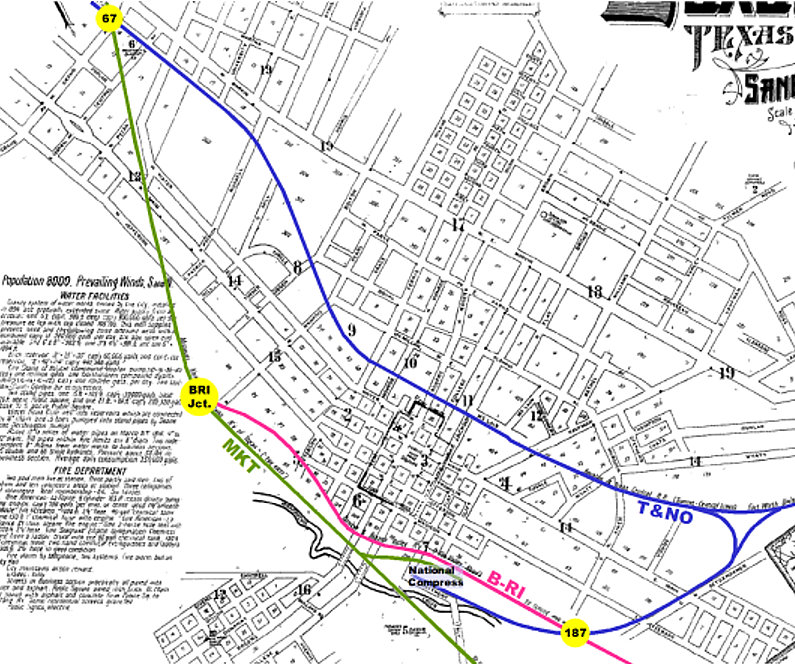www.txrrhistory.com - Tower 187 - Waxahachie
A Crossing of the Burlington - Rock Island Railroad and the
Texas & New Orleans Railroad
In the early 1900s, B. F. Yoakum controlled both the
St. Louis - San Francisco Railway ("Frisco") and the Rock Island Lines,
two large railroad companies. He also controlled a collection
of other railroad companies in south Texas known as the Gulf Coast
Lines. As the Frisco and Rock Island railroads built south into Texas from
Indian territory (Oklahoma), Yoakum sought a connection with his Gulf Coast
Lines by building a main line between Dallas and Houston. He accomplished this
by acquiring the charter of the Trinity and Brazos Valley (T&BV) Railway, a
small shortline operating between Mexia and Cleburne. In 1907, he built north
and south from the town of Teague, reaching Waxahachie to the north and Houston
to the south. Waxahachie was already served by two major railroads, the
Missouri-Kansas-Texas (MKT) and the Houston & Texas Central, a Southern Pacific
property that was eventually merged into its Texas & New Orleans (T&NO)
subsidiary. (The MKT and H&TC crossed in northwest Waxahachie at
Tower 67.) Yoakum stopped in Waxahachie rather than continuing into Dallas
because he was able to make a favorable trackage rights arrangement into Dallas
on the MKT line. For seven years,
the T&BV enjoyed great business carrying overhead traffic
between Dallas and Houston via Waxahachie. In 1914, Yoakum lost control of the
Frisco and Rock Island companies, and the T&BV went into a
long receivership lasting 16 years. When it ended in
1930, a new company, the Burlington - Rock Island
(B-RI) Railroad, was created to own and operate the ex-T&BV rail lines. B-RI was
owned jointly by Burlington Northern, operating under subsidiary Ft. Worth &
Denver (FW&D) Railway, and Rock Island. B-RI continued the MKT trackage rights
arrangement into Dallas that T&BV had used, and their connection to the Katy
became known as "BRI Junction". Until the demise
of Rock Island in 1980, both Rock Island and FW&D shared operations over
the line, and the route was commonly known as the "Joint Texas Division"
(JTD). B-RI
was always a paper railroad -- it never owned any
rolling stock -- and it became absorbed into the Burlington System
when Rock Island went bankrupt. Burlington System successor Burlington Northern
Santa Fe (BNSF) still operates the route to Houston. It acquired the Katy tracks
north of Waxahachie from Katy successor Union Pacific, providing a complete
route to Dallas which see frequent traffic.
Sometime in the 1890s, National Compress Co. built a cotton compress in
downtown Waxahachie near the Katy depot. The compress is visible on the 1898
Sanborn Fire Insurance Map of Waxahachie, served by spur tracks
from both the Katy and the H&TC. The Katy spur was relatively short since the
main line was close by, but the H&TC spur needed nearly a mile of track to reach
the compress. When the T&BV built into Waxahachie in 1907, it crossed the H&TC
spur at grade. Presumably, as an uncontrolled crossing, all trains would have
been required to come to a complete stop. However, since virtually all B-RI
trains would stop at the depot less than a half mile from the crossing, this may
not have created much additional delay. It is also possible that if the crossing
was within the "yard limits" of the B-RI, other operational procedures might
have taken precedent.
The H&TC was formally merged into the T&NO in 1934, and sometime between 1937
and 1942, Tower 187 was established to control the B-RI crossing of the T&NO
spur to National Compress. It was most likely a remote-controlled interlocker,
with controls probably located at the B-RI passenger depot. The impetus for
establishing an interlocker at the crossing during this time frame is not known.
However, it is worth noting that beginning with Tower
182 at Prosser in 1936, several interlockers involving the T&NO were
established at "minor" crossings, including Tower 186,
a similar situation in Sherman where a T&NO spur crossed a Frisco main line.
Perhaps T&NO had embarked on a project to improve operations and safety
throughout their system.
Historic Map, Waxahachie

Above: This Sanborn Fire Insurance Index Map of Waxahachie has been annotated
to show the railroads, towers
and junctions
in Waxahachie as of the 1940s.
Below: This 1925 Sanborn Map shows National Compress Co. served by two rail
spurs. To the left (south) of the
complex
along Matthews St., the H&TC spur is visible ending short of S. Flat St. To the
right (north) of the complex,
the Katy spur
crosses S. Flat St. heading toward the Katy main line. The T&BV main line is
located to the right of
the Katy
spur, passing along side the City Water Works and the J. T. Andrews & Sons Gin
Co.

Satellite Image, Tower 187 Site

Recent Photos, Waxahachie (Jim King, January, 2008)
Click to Enlarge
|
|

|
|
Rails are visible where the T&NO spur to National Compress crossed Jefferson at the Getzendaner St. intersection. |
|

|
|
With the abandonment of the Katy, there's no longer a junction at BRI Jct. The Katy depot is visible in the distance. |
|

|
|
The Katy passenger depot sits abandoned. |
|
|
|

|
|
The B-RI passenger depot is used as an office by a local business. |
|

|
|
A BNSF freight idles next to the abandoned Katy spur on the north side of the former National Compress site. |
|

|
|
Along Mathews St., the T&NO spur ran along the south side of National Compress, now a warehouse site. |
|
|








